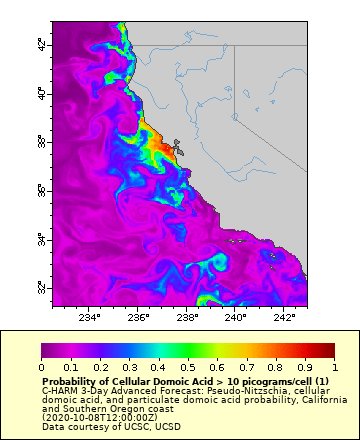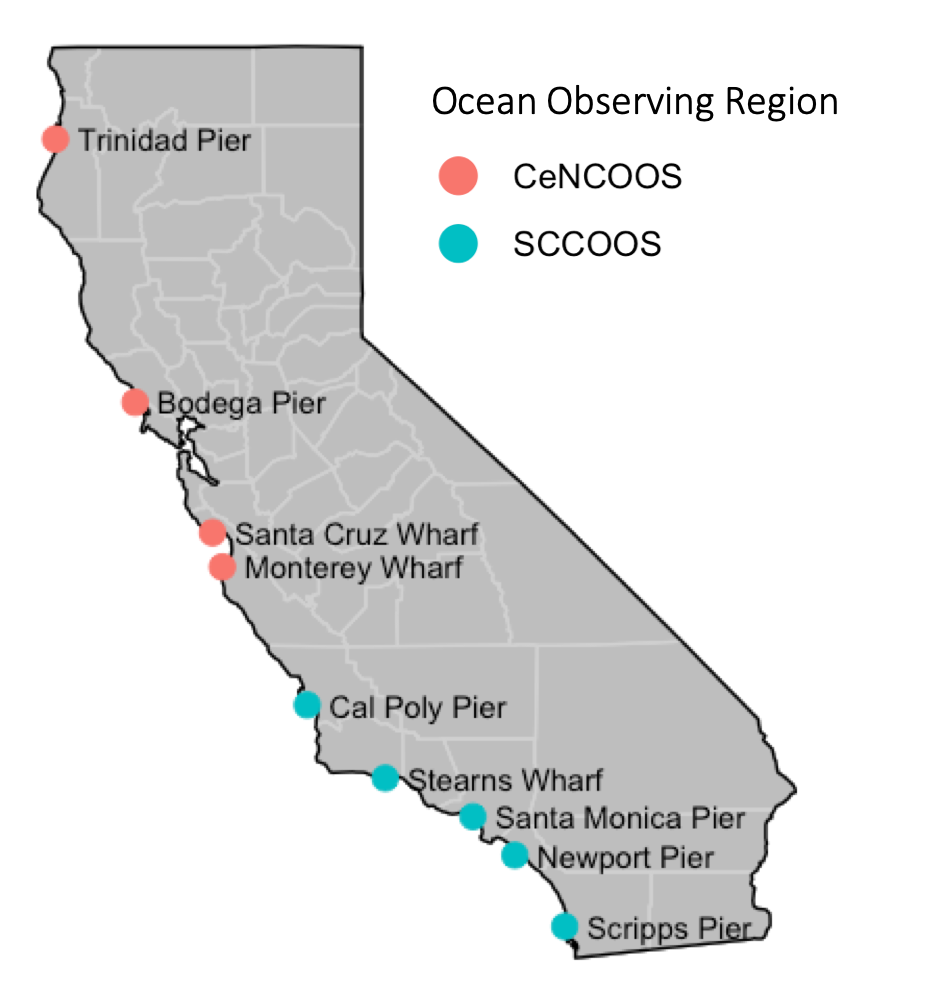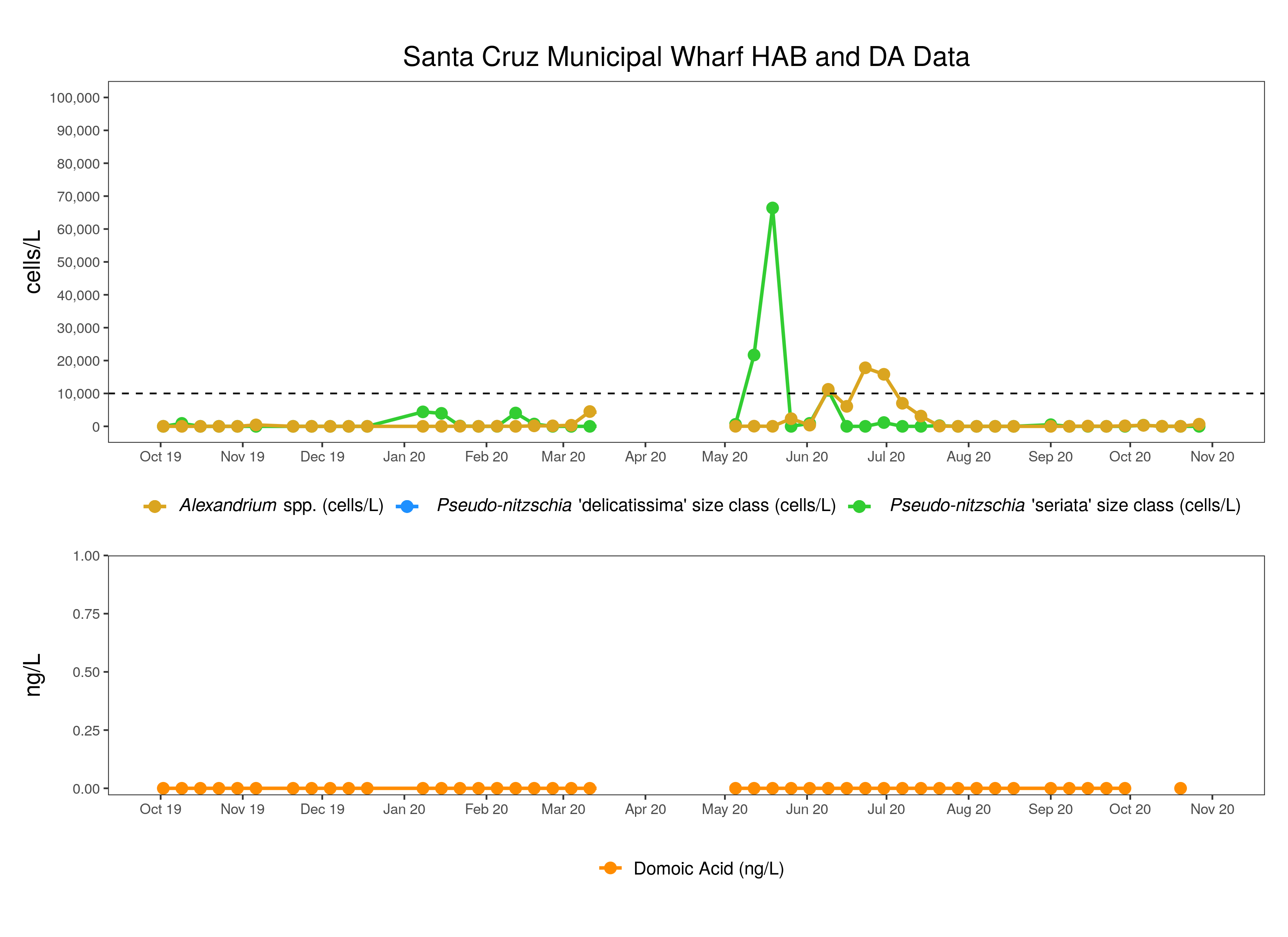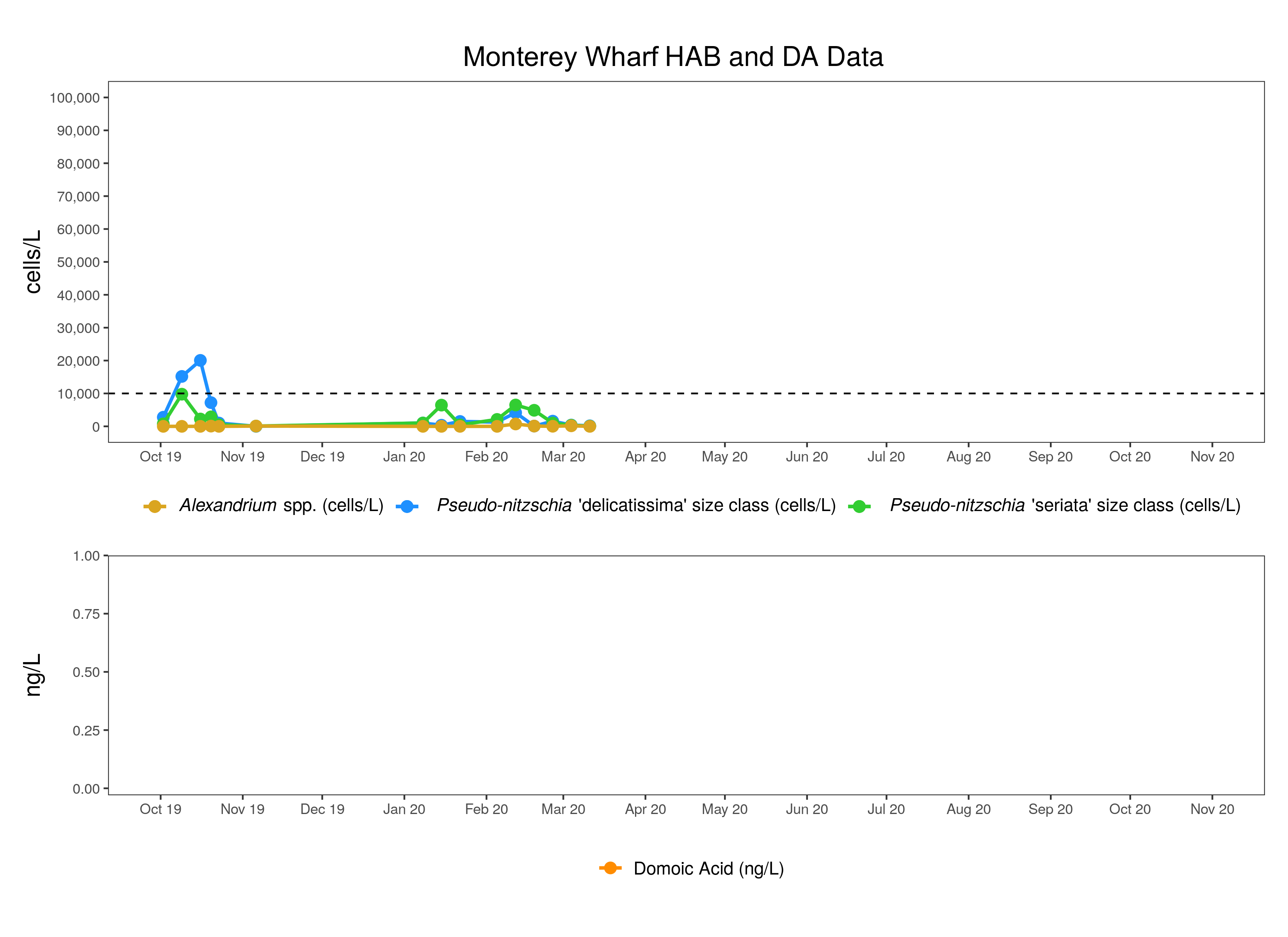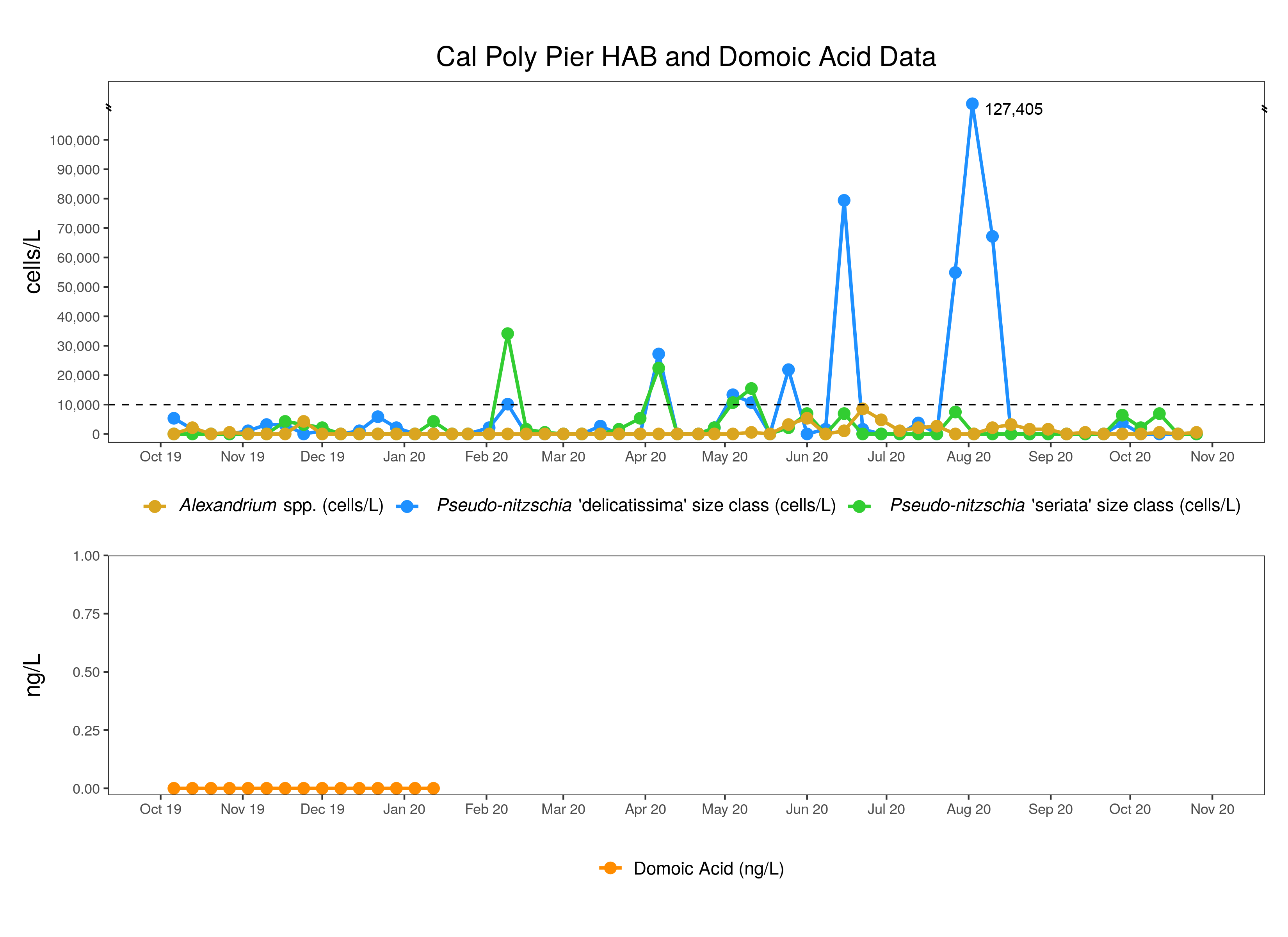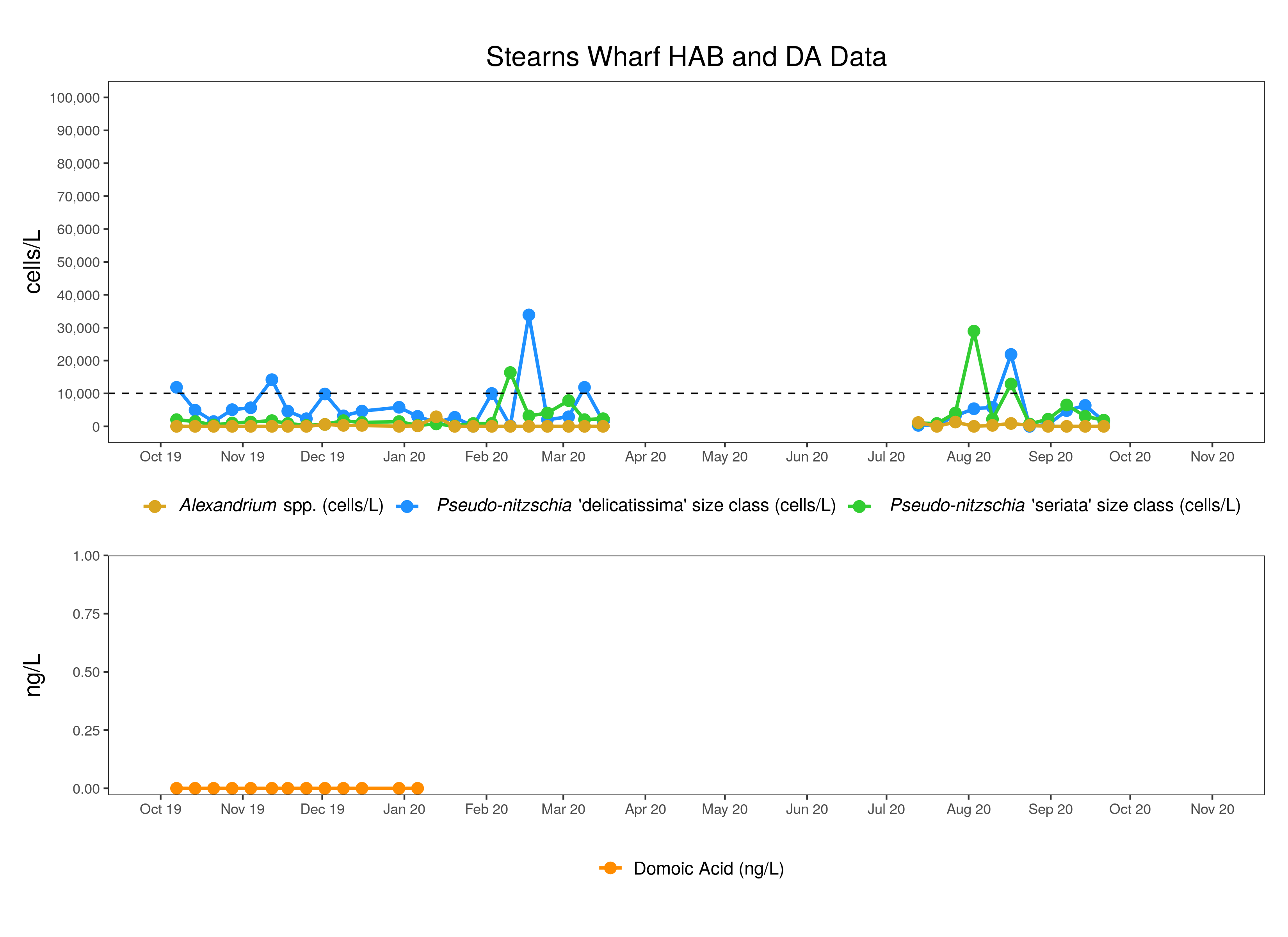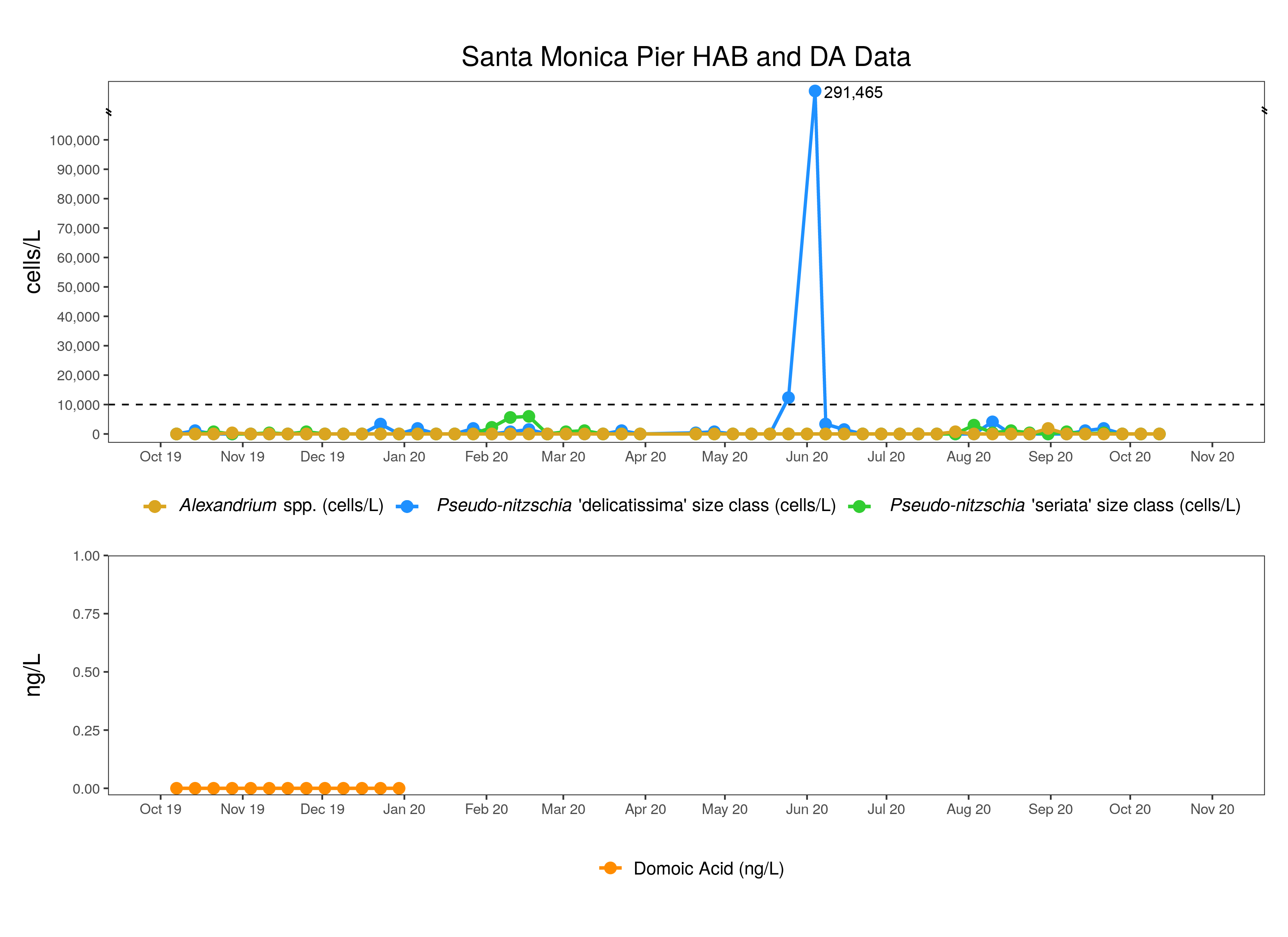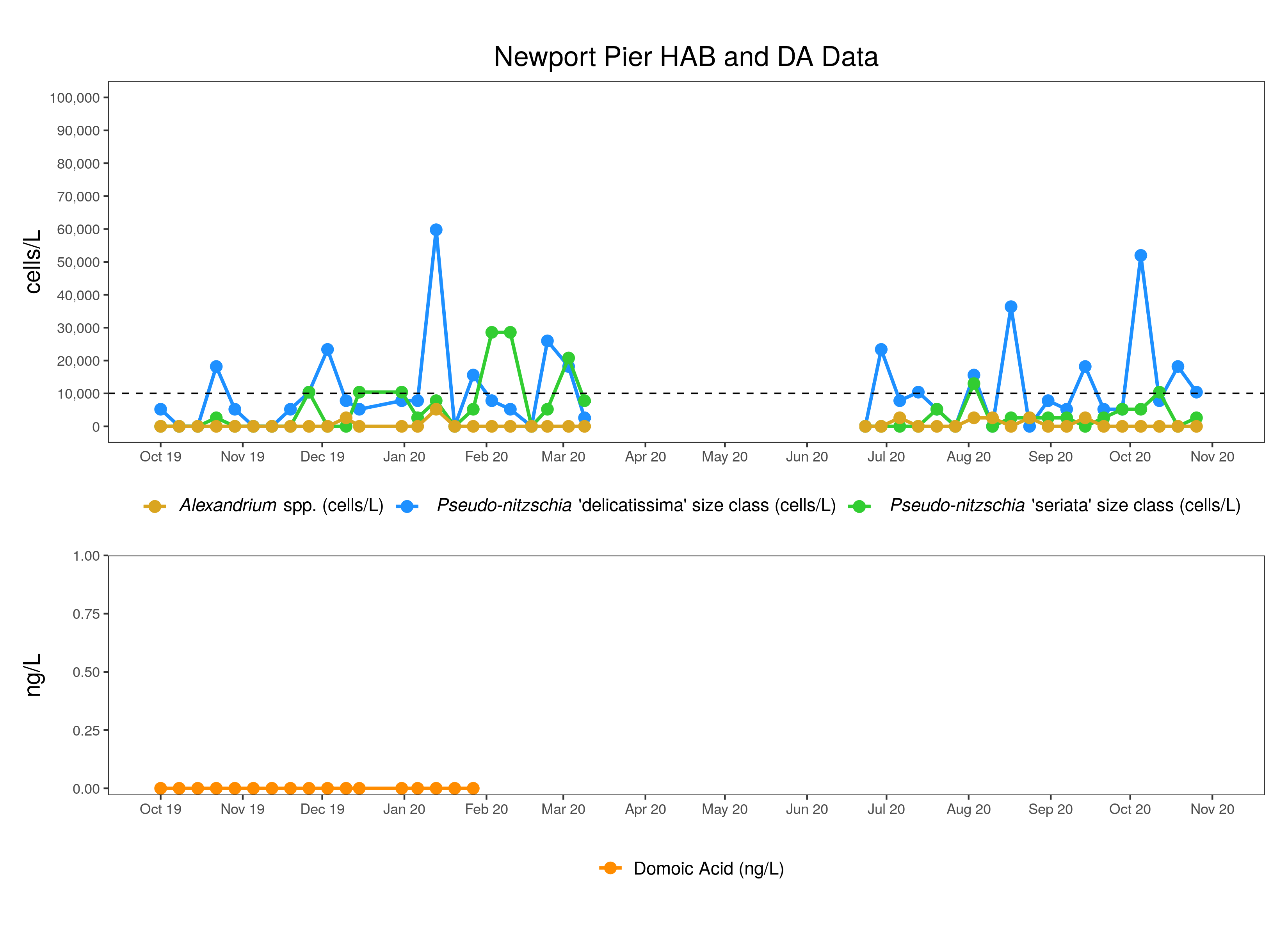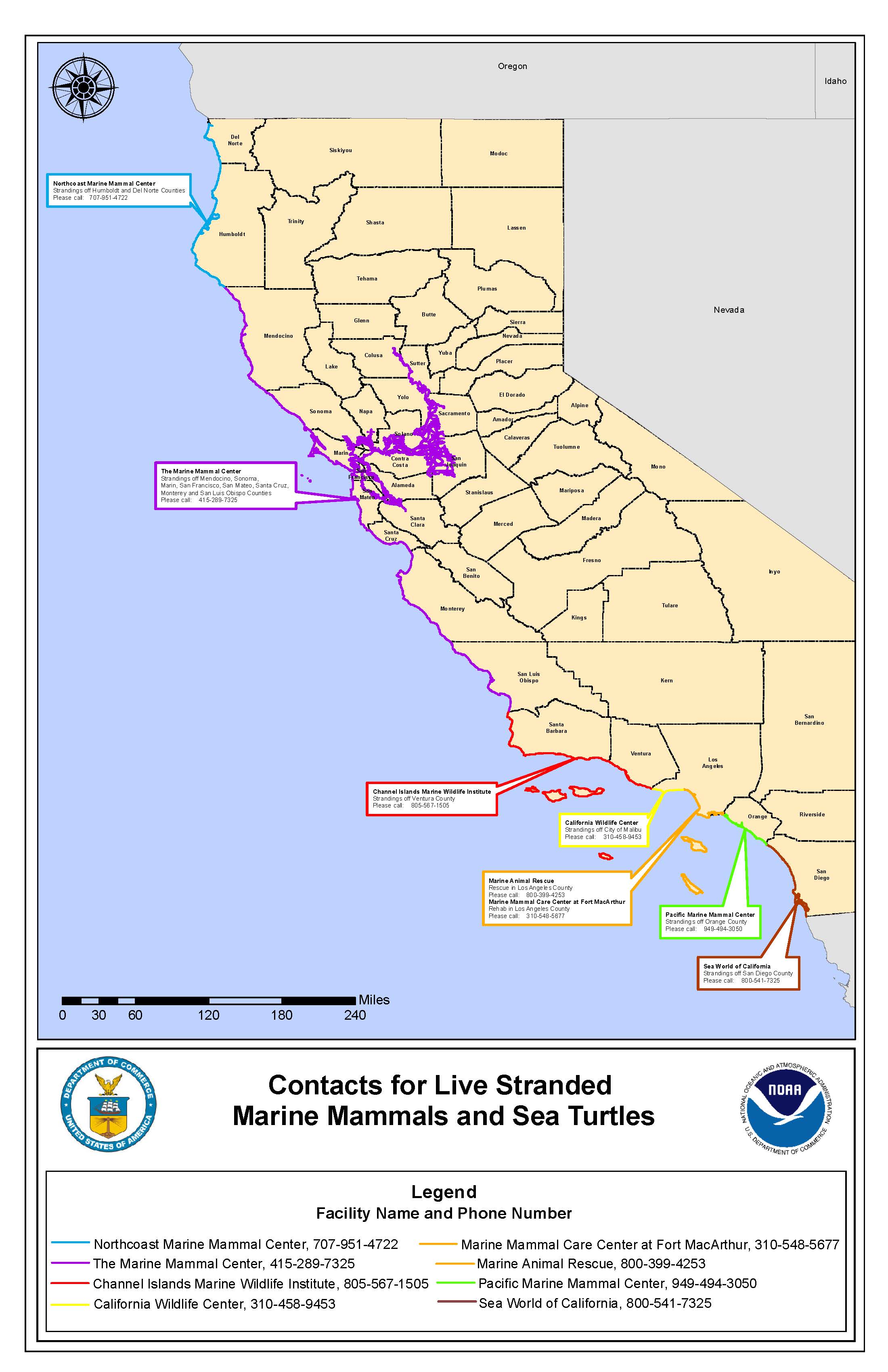Be sure to also read the special Red Tide Bulletin: Spring 2020
Pseudo-nitzschia - C-HARM tells us where conditions are suitable for species of the diatom Pseudo-nitzschia spp. (all size classes) to grow well and where they might be more likely to produce the deadly neurotoxin, domoic acid (DA). The predicted suitable habitat for Pseudo-nitzschia spp. was spread throughout coastal California from the Santa Barbara Channel to the Oregon border in October, a pattern in the C-HARM model that has persisted but with some nuances each month. This indicates that C-HARM is predicting positive habitat suitability for the genus Pseudo-nitzschia in most parts of coastal California much of the time, something that is corroborated by the frequent presence of Pseudo-nitzschia species at our pier sites, albeit not always at bloom levels. In general, most of the coast in October exhibits persistently high bloom probabilities, with enhanced variability for Southern California. While COVID-19 sampling restrictions continue to hamper our ability to acquire timely HABMAP observations from piers, we do know that the abundance of the toxigenic Pseudo-nitzschia "seriata" size class remained at zero at Santa Cruz Wharf throughout October. This is both consistent and inconsistent with the C-HARM bloom probabilities at the pixel near the SC Wharf since they were variable, bouncing between zero and 100% probability for bloom levels of Pseudo-nitzschia spp., albeit with less variability than in September. At Cal Poly Pier, the observed abundance of both Pseudo-nitzschia size classes showed some uptick in September and October but never quite reached "operational" bloom levels, consistent with the high variability for Pseudo-nitzschia bloom risk in San Luis Obispo area throughout the month (and previous months). As in September, the only southern California site where bloom levels were reached was at Newport Beach Pier in Orange County; although this time both size classes, Pseudo-nitzschia 'delicatissima' and 'seriata,' reached or well exceeded the bloom threshold (noting that data are not yet available for Scripps Pier due to COVID-related delays and personnel challenges). The highest Relative Abundance Index (RAI) for the Pseudo-nitzschia 'seriata' size class recorded by the CDPH was located within Humboldt Bay and on the Mendocino Coast. Elevated RAI was recorded at sites near San Luis Obispo and Los Angeles-Orange Counties, also consistent with the C-HARM outlook for October.
Moderate to very high probabilities (60-100%) of particulate DA (pDA) were predicted at different times for several sections of the California coastline in October, with a protracted offshore extent relative to that predicted for previous months. South of the Santa Barbara Channel, pDA was predicted to frequently exceed the 500 ng/L threshold at hot spots in and around Los Angeles, Orange County, and San Diego Counties, and as with Pseudo-nitzschia predictions, those high probabilities extended fairly far offshore. Probabilities peaked for Santa Barbara Channel mid-month, indicating a relative high-risk zone in and around the Channel and Pt. Conception at that time. Probabilities for pDA along the central coast from Carmel to San Luis Obispo County exhibited local minima in the nearshore, sometimes dipping into zero probability of high pDA in the SLO region, a pattern that also was seen for large swaths of the Sonoma, Mendocino, and Humboldt coasts in northern California. Monterey Bay pDA probabilities remained low to moderate (0-60%) for most of October. Early in the month, the area around SF Bay and Marin County was predicted to be a high-risk hot spot that seemed to slowly move up the coast, with high risk predicted along the North Coast for the second half of the month. Much like pDA, predicted cellular DA (cDA) risk was focused around the SF Bay and Marin County/Sonoma County early in the month and seemed to move up the coast, peaking along the North Coast later in the month, with a rather large offshore extent to the high (80-100%) cDA probabilities. The overall take-away, as in the previous two months, is that cDA probabilities were frequently high along the North and Sonoma Coasts (including areas adjacent to SF Bay), suggesting a possible issue there for domoic acid. The very high probabilities for pDA (and cDA) near SF Bay and surrounding counties were consistent with the two California Sea Lion strandings from suspected DA toxicosis reported by The Marine Mammal Center (TMMC) from San Mateo and Sonoma Counties. However, there were even more stranding reported for Santa Cruz and Monterey Counties where only moderate pDA probabilities were seen and low cDA risk in October. Either those animals acquired the toxin in a neighboring region of the coast or in the subsurface zone not represented by C-HARM, or the model's DA prediction was not very accurate. Domoic acid measurements in the Santa Cruz Wharf from HABMAP sampling showed no DA in October. One last sea lion stranding was reported by MCCLA mid-month in the Los Angeles area, consistent with predictions of intermittently high pDA risk.
Alexandrium - CDPH recorded low or zero Alexandrium spp. at all sites sampled in October, consistent with abundances observed/reported by HABMAP at piers. However, Health Advisories due to elevated PSP toxins were issued in late October and November for Humboldt, Mendocino, and Sonoma counties warning consumers not to eat recreationally harvested bivalve shellfish.
*Please note that HABMAP sampling, CDPH sampling, and marine mammal rescues have been greatly reduced in response to COVID-19 safety measures.
Harmful Algal Bloom Monitoring & Alert Program (HABMAP)
**HABMAP sampling resumed after being suspended in March in accordance with the Governor's stay at home order. However, COVID-19 safety protocols and sampling restrictions may continue to affect operations and delay results.**
Note that data for some stations are not shown because they are not yet recorded in the public HABMAP archive.
Differentiating Pseudo-nitzschia species by light microscopy is difficult. For this reason, Pseudo-nitzschia "seriata" does not refer to an actual species but rather the larger size class of Pseudo-nitzschia, which is generally a more toxigenic group of species. Alternatively, Pseudo-nitzschia "delicatissima" refers to the smaller size class that is generally non-toxigenic. The dashed line on the plots demarcates the 10,000 cells/L "bloom" threshold designated here for Pseudo-nitzschia populations only.
More information and data visualizations on the statewide HAB network and forecasting system can be found on the California HABMAP website and on the SCCOOS Harmful Algal Bloom page.
Santa Cruz Wharf
Water samples were collected at Santa Cruz Wharf 4 times in October. Molecular probes for toxigenic Pseudo-nitzschia in the "seriata" class are conducted for this site, and was detected only on Oct 6. Alexandrium spp. were detected every time (Oct 6, 13, 20, 27). Domoic acid results are not yet available.
The Santa Cruz Wharf shore station is supported by CeNCOOS PI Raphael Kudela at UCSC.
Monterey Wharf
Water sampling has been suspended at Monterey Wharf since March 2020 in response to COVID-19 safety measures.
Monterey Wharf shore station is supported by CeNCOOS PI's Raphael Kudela at USCS and Jason Smith and Moss Landing Marine Labs.
Cal Poly Pier
Water samples were collected 4 times at Cal Poly Pier in October. Pseudo-nitzschia "delicatissima" was not detected during this time while Pseudo-nitzschia "seriata" was detected on Oct 5 and Oct 12. Alexandrium spp. were detected on Oct 12 and Oct 26. No detections were above bloom levels. Domoic acid results are not yet available.
Cal Poly Pier shore station is supported by SCCOOS PI Ryan Walter and Ally Pasulka at Cal Poly.
Stearns Wharf
No samples were collected at Stearns Wharf in October.
Stearns Wharf is supported by SCCOOS PI Mark Brzezinski and Libe Washburn at UCSB.
Santa Monica Pier
Water samples were collected twice at Santa Monica Pier in October. Pseudo-nitzschia "delicatissima", Pseudo-nitzschia "seriata" and Alexandrium spp. were not detected in any samples and domoic acid results are not yet available.
Santa Monica Pier shore station is supported by SCCOOS PI Rebecca Shipe at UCLA.
Newport Pier
Water samples were collected 4 times at Newport Beach Pier in October. Pseudo-nitzschia "delicatissima" was detected in each sample above bloom levels except on Oct 12. Pseudo-nitzschia "seriata" was detected in 3 of the 4 samples, with only Oct 12 above bloom levels. Alexandrium spp. were not detected and domoic acid results are not yet available.
Newport Beach Pier is supported by SCCOOS PI David Caron at USC.
Scripps Pier
Scripps Pier water samples are not yet available for April through October 2020.
Scripps Pier is supported by SCCOOS and PIs Melissa Carter and Clarissa Anderson at UCSD.
CDPH observations for Pseudo-nitzschia 'seriata' and Alexandrium spp.
Please note, starting in July 2019, CDPH moved to only reporting Pseudo-nitzschia of the seriata complex and not all Pseudo-nitzschia spp. as previously provided.
From 1-31 October 2020, water samples were collected by volunteers and sent to the California Department of Public Health (CDPH) for analysis. Pseudo-nitzschia 'seriata' group was detected in 55 of the 102 samples. Pseudo-nitzschia 'seriata' was detected at "Common" density levels (using CDPH relative abundance index) on 6 occasions: October 12, 16, 19, 26 (2 locations) at Humboldt Bay (20%, 25%, 15%, 15%, 25% composition, respectively), and on October 19 at Mendocino (20% composition). Alexandrium spp. were detected in 33 of the 102 samples in the month of October. Alexandrium spp. were detected at "Present" density levels on 5 occasions or below.
You can view an interactive map and data table of CDPH data from January 2019 to present developed by SCCOOS below or you can also view CDPH Toxic Phytoplankton Observations Map with layers of Pseudo-nitzschia and Alexandrium spp. as well as other phytoplankton species observations (in the pop-up windows).
Data are provided by the California Department of Public Health, Environmental Management Branch.
CDPH and OEHHA Health Advisories
November 18. California Department of Public Health (CDPH) is advising consumers not to eat sport-harvested mussels, clams, or whole scallops from Mendocino County due to dangerous levels of paralytic shellfish poisoning (PSP) toxins.
November 12. CDPH is advising consumers not to eat sport-harvested mussels, clams, or whole scallops from Humboldt County due to dangerous levels of paralytic shellfish poisoning (PSP) toxins.
October 30. CDPH announced the statewide annual quarantine on mussels gathered by sport harvesters along the California coast, except for Sonoma County, ends at midnight on Saturday, October 31, 2020. CDPH is advising consumers not to eat sports-harvested mussels, clams, or whole scallops from Sonoma County. Dangerous levels of PSP toxins have been detected in mussels from this area making them unsafe to consume.
For the latest closures and updates, please visit the CDPH Health Advisories page as a central location of information related to CDPH health advisories. Also available is a map showing the current CDPH Recreational Bivalve Shellfish Advisories (see below).
NEWS: The HAB-related illness workgroup has developed a new webpage for marine HAB-related illness tracking work (https://oehha.ca.gov/fish/general-info/marine-harmful-algal-bloom-hab-related-illness-tracking).
California Marine Mammal and Seabird Strandings from Suspected DA Toxicosis
Domoic acid (DA) is a potent neurotoxin produced by some diatom species of the genus Pseudo-nitzschia. Species exposed to DA can result in seizures, epilepsy, cardiomyopathy, and death depending upon the ingested dose. DA toxicosis commonly occurs in California Sea Lions (Zalophus californianus), presumably due to a combination of foraging behavior and seasonal movements. The Marine Mammal Center (TMMC), Channel Islands Marine Wildlife Institute (CIMWI), California Wildlife Center (CWC), Marine Mammal Care Center Los Angeles (MMCC-LA), Marine Animal Rescue (MAR), the Pacific Marine Mammal Center (PMMC), and SeaWorld act like an emergency room by working to rescue and rehabilitate sick and injured marine mammals, seabirds, and sea turtles.
Among the seven rehabilitation centers we received data for in the month of October 8 marine mammal stranding presented with symptoms of domoic acid toxicosis.
The Channel Islands Marine Wildlife Institute (CIMWI), Pacific Marine Mammal Center (PMMC) and Marine Animal Rescue (MAR) did not record any strandings due to suspected domoic acid in October 2020.
October strandings due to suspected DA toxicosis occurred in the following counties:
- Los Angeles (MCCLA)
- October 13 - adult, female, California Sea Lion
- Santa Cruz (TMMC)
- October 18 - yearling, male, California Sea Lion
- October 21 - adult, female, California Sea Lion
- October 28 - adult, female, California Sea Lion
- Monterey (TMMC)
- October 13 - subadult, male, California Sea Lion
- October 23 - adult, female, California Sea Lion
- Sonoma (TMMC)
- October 18 - subadult, female, California Sea Lion
- San Mateo (TMMC)
- October 2 - yearling, male, California Sea Lion
At this time we do not have data from the North Coast Marine Mammal Center.
Please subscribe to CA HAB Bulletin listserv to receive the monthly CA HAB Bulletin.



